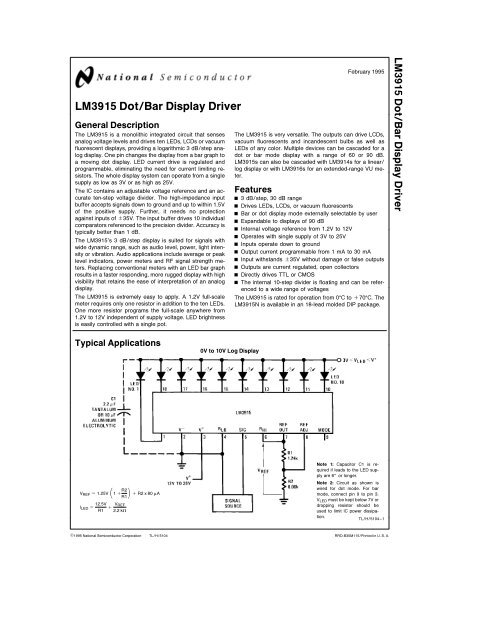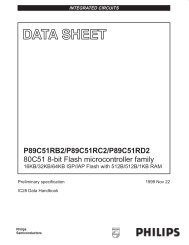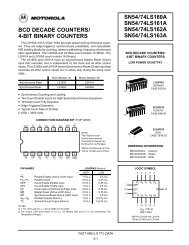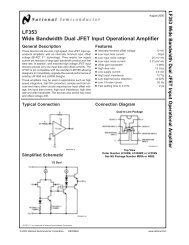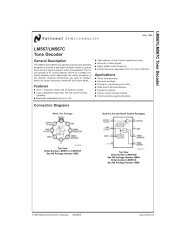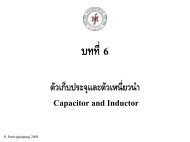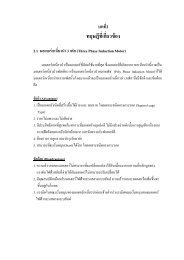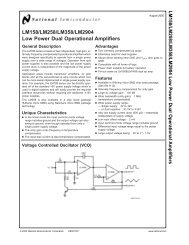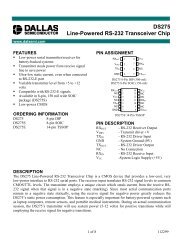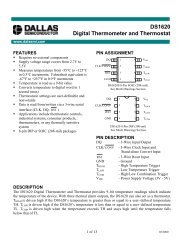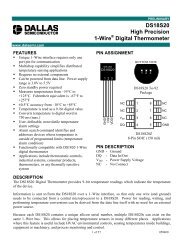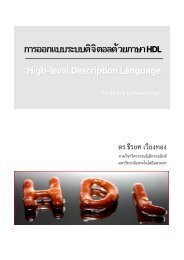Create successful ePaper yourself
Turn your PDF publications into a flip-book with our unique Google optimized e-Paper software.
<strong>LM3915</strong> <strong>Dot</strong><strong>Bar</strong> <strong>Display</strong> <strong>Driver</strong><br />
General Description<br />
The <strong>LM3915</strong> is a monolithic integrated circuit that senses<br />
analog voltage levels and drives ten LEDs LCDs or vacuum<br />
fluorescent displays providing a logarithmic 3 dBstep analog<br />
display One pin changes the display from a bar graph to<br />
a moving dot display LED current drive is regulated and<br />
programmable eliminating the need for current limiting resistors<br />
The whole display system can operate from a single<br />
supply as low as 3V or as high as 25V<br />
The IC contains an adjustable voltage reference and an accurate<br />
ten-step voltage divider The high-impedance input<br />
buffer accepts signals down to ground and up to within 15V<br />
of the positive supply Further it needs no protection<br />
against inputs of g35V The input buffer drives 10 individual<br />
comparators referenced to the precision divider Accuracy is<br />
typically better than 1 dB<br />
The <strong>LM3915</strong>’s 3 dBstep display is suited for signals with<br />
wide dynamic range such as audio level power light intensity<br />
or vibration Audio applications include average or peak<br />
level indicators power meters and RF signal strength meters<br />
Replacing conventional meters with an LED bar graph<br />
results in a faster responding more rugged display with high<br />
visibility that retains the ease of interpretation of an analog<br />
display<br />
The <strong>LM3915</strong> is extremely easy to apply A 12V full-scale<br />
meter requires only one resistor in addition to the ten LEDs<br />
One more resistor programs the full-scale anywhere from<br />
12V to 12V independent of supply voltage LED brightness<br />
is easily controlled with a single pot<br />
February 1995<br />
The <strong>LM3915</strong> is very versatile The outputs can drive LCDs<br />
vacuum fluorescents and incandescent bulbs as well as<br />
LEDs of any color Multiple devices can be cascaded for a<br />
dot or bar mode display with a range of 60 or 90 dB<br />
<strong>LM3915</strong>s can also be cascaded with LM3914s for a linear<br />
log display or with LM3916s for an extended-range VU meter<br />
Features<br />
Y 3 dBstep 30 dB range<br />
Y Drives LEDs LCDs or vacuum fluorescents<br />
Y <strong>Bar</strong> or dot display mode externally selectable by user<br />
Y Expandable to displays of 90 dB<br />
Y Internal voltage reference from 12V to 12V<br />
Y Operates with single supply of 3V to 25V<br />
Y Inputs operate down to ground<br />
Y Output current programmable from 1 mA to 30 mA<br />
Y Input withstands g35V without damage or false outputs<br />
Y Outputs are current regulated open collectors<br />
Y Directly drives TTL or CMOS<br />
Y The internal 10-step divider is floating and can be referenced<br />
to a wide range of voltages<br />
The <strong>LM3915</strong> is rated for operation from 0C toa70C The<br />
<strong>LM3915</strong>N is available in an 18-lead molded DIP package<br />
<strong>LM3915</strong> <strong>Dot</strong><strong>Bar</strong> <strong>Display</strong> <strong>Driver</strong><br />
Typical Applications<br />
0V to 10V Log <strong>Display</strong><br />
V REF e 125V<br />
1 aR2<br />
R1J a R2x80mA<br />
I LED e 125V<br />
R1<br />
a V REF<br />
22 kX<br />
Note 1 Capacitor C1 is required<br />
if leads to the LED supply<br />
are 6 or longer<br />
Note 2 Circuit as shown is<br />
wired for dot mode For bar<br />
mode connect pin 9 to pin 3<br />
V LED must be kept below 7V or<br />
dropping resistor should be<br />
used to limit IC power dissipation<br />
TLH5104–1<br />
C1995 National Semiconductor Corporation<br />
TLH5104<br />
RRD-B30M115Printed in U S A
Absolute Maximum Ratings<br />
If MilitaryAerospace specified devices are required<br />
please contact the National Semiconductor Sales<br />
OfficeDistributors for availability and specifications<br />
Power Dissipation (Note 5)<br />
Molded DIP(N)<br />
Supply Voltage<br />
Voltage on Output <strong>Driver</strong>s<br />
1365 mW<br />
25V<br />
25V<br />
Electrical Characteristics (Notes 1 and 3)<br />
Input Signal Overvoltage (Note 3)<br />
Divider Voltage<br />
Reference Load Current<br />
Storage Temperature Range<br />
Lead Temperature (Soldering 10 sec)<br />
g35V<br />
b100 mV to V a<br />
10 mA<br />
b55Ctoa150C<br />
260C<br />
Parameter Conditions (Note 1) Min Typ Max Units<br />
Comparators<br />
Offset Voltage Buffer and First<br />
0V s V RLO e V RHI<br />
s 12V<br />
Comparator<br />
I LED e 1mA<br />
3 10 mV<br />
Offset Voltage Buffer and Any Other<br />
0V s V RLO e V RHI<br />
s 12V<br />
Comparator<br />
I LED e 1mA<br />
3 15 mV<br />
Gain (DI LED DV IN ) I L(REF) e 2 mA I LED e 10 mA 3 8 mAmV<br />
Input Bias Current (at Pin 5) 0V s V IN<br />
s (V a b 15V) 25 100 nA<br />
Input Signal Overvoltage No Change in <strong>Display</strong> b35 35 V<br />
Voltage-Divider<br />
Divider Resistance Total Pin 6 to 4 16 28 36 kX<br />
Relative Accuracy (Input Change (Note 2)<br />
Between Any Two Threshold Points)<br />
20 30 40 dB<br />
Absolute Accuracy at Each Threshold Point (Note 2)<br />
V IN eb3 b6dB b05 a05 dB<br />
V IN eb9dB b05 a065 dB<br />
V IN eb12 b15 b18 dB b05 a10 dB<br />
V IH eb21 b24 b27 dB b05 a15 dB<br />
Voltage Reference<br />
Output Voltage<br />
01 mA s I L(REF)<br />
s 4 mA<br />
V a e V LED e 5V<br />
12 128 134 V<br />
Line Regulation 3V s V a s 18V 001 003 %V<br />
Load Regulation<br />
01 mA s I L(REF)<br />
s 4 mA<br />
V a e V LED e 5V<br />
04 2 %<br />
Output Voltage Change with Temperature 0C s T A<br />
s a70C I L(REF) e 1 mA<br />
V a e V LED 5V<br />
1 %<br />
Adjust Pin Current 75 120 mA<br />
2
Electrical Characteristics (Note 1) (Continued)<br />
Output <strong>Driver</strong>s<br />
Parameter Conditions (Note 1) Min Typ Max Units<br />
LED Current V a e V LED e 5V I L(REF) e 1 mA 7 10 13 mA<br />
LED Current Difference (Between Largest V LED e 5V I LED e 2 mA 012 04 mA<br />
and Smallest LED Currents)<br />
V LED e 5V I LED 20 mA<br />
12 3 mA<br />
LED Current Regulation 2V s V LED<br />
s 17V I LED e 2 mA 01 025 mA<br />
I LED e 20 mA<br />
1 3 mA<br />
Dropout Voltage<br />
I LED(ON) e 20 mA V LED e 5V<br />
DI LED e 2mA<br />
Saturation Voltage I LED e 20 mA I L(REF) e 04 mA 015 04 V<br />
Output Leakage Each Collector <strong>Bar</strong> Mode (Note 4) 01 10 mA<br />
Output Leakage <strong>Dot</strong> Mode (Note 4)<br />
Pins 10-18 01 10 mA<br />
Pin 1<br />
60 150 450 mA<br />
Supply Current<br />
Standby Supply Current V a ea5V I L(REF) e 02 mA 24 42 mA<br />
(All Outputs Off)<br />
V a ea20V I L(REF) e 10 mA<br />
61 92 mA<br />
Note 1 Unless otherwise stated all specifications apply with the following conditions<br />
3V DC<br />
s V a s 20 V DC b0015V s V RLO<br />
s 12 V DC T A e 25C I L(REF) e 02 mA pin 9 connected to pin 3 (bar mode)<br />
3V DC<br />
s V LED<br />
s V a V REF V RHI V RLO<br />
s (V a b 15V) For higher power dissipations pulse testing is used<br />
b0015V s V RHI<br />
s 12 V DC 0V s V IN<br />
s V a b 15V<br />
Note 2 Accuracy is measured referred to 0 dB ea10000 V DC at pin 5 with a 10000 V DC at pin 6 and 0000 V DC at pin 4 At lower full scale voltages buffer<br />
and comparator offset voltage may add significant error See table for threshold voltages<br />
Note 3 Pin 5 input current must be limited to g3 mA The addition of a 39k resistor in series with pin 5 allows g100V signals without damage<br />
Note 4 <strong>Bar</strong> mode results when pin 9 is within 20 mV of V a <strong>Dot</strong> mode results when pin 9 is pulled at least 200 mV below V a LED 10 (pin 10 output current) is<br />
disabled if pin 9 is pulled 09V or more below V LED <br />
Note 5 The maximum junction temperature of the <strong>LM3915</strong> is 100C Devices must be derated for operation at elevated temperatures Junction to ambient thermal<br />
resistance is 55CW for the molded DIP (N package)<br />
THRESHOLD VOLTAGE (Note 2)<br />
Output dB Min Typ Max Output dB Min Typ Max<br />
1 b27 0422 0447 0531 6 b12 2372 2512 2819<br />
2 b24 0596 0631 0750 7 b9 3350 3548 3825<br />
3 b21 0841 0891 1059 8 b6 4732 5012 5309<br />
4 b18 1189 1259 1413 9 b3 6683 7079 7498<br />
5 b15 1679 1778 1995 10 0 9985 10 10015<br />
15<br />
V<br />
3
Typical Performance Characteristics<br />
Supply Current vs<br />
Temperature<br />
Operating Input Bias<br />
Current vs Temperature<br />
Reference Voltage vs<br />
Temperature<br />
Reference Adjust Pin<br />
Current vs Temperature<br />
LED Current-Regulation<br />
Dropout<br />
LED <strong>Driver</strong> Saturation<br />
Voltage<br />
Input Current Beyond<br />
Signal Range (Pin 5)<br />
LED Current vs<br />
Reference Loading<br />
LED <strong>Driver</strong> Current<br />
Regulation<br />
Total Divider Resistance<br />
vs Temperature<br />
Common-Mode Limits<br />
Output Characteristics<br />
TLH5104–2<br />
TLH5104–3<br />
4
Block Diagram (Showing Simplest Application)<br />
TLH5104–4<br />
5
Functional Description<br />
The simplified <strong>LM3915</strong> block diagram is included to give the<br />
general idea of the circuit’s operation A high input impedance<br />
buffer operates with signals from ground to 12V and is<br />
protected against reverse and overvoltage signals The signal<br />
is then applied to a series of 10 comparators each of<br />
which is biased to a different comparison level by the resistor<br />
string<br />
In the example illustrated the resistor string is connected to<br />
the internal 125V reference voltage In this case for each<br />
3 dB that the input signal increases a comparator will<br />
switch on another indicating LED This resistor divider can<br />
be connected between any 2 voltages providing that they<br />
are at least 15V below V a and no lower than V b <br />
INTERNAL VOLTAGE REFERENCE<br />
The reference is designed to be adjustable and develops a<br />
nominal 125V between the REF OUT (pin 7) and REF ADJ<br />
(pin 8) terminals The reference voltage is impressed across<br />
program resistor R1 and since the voltage is constant a<br />
constant current I 1 then flows through the output set resistor<br />
R2 giving an output voltage of<br />
R2<br />
V OUT e V REF 1a<br />
R1J a I ADJ R2<br />
TLH5104–5<br />
Since the 120 mA current (max) from the adjust terminal<br />
represents an error term the reference was designed to<br />
minimize changes of this current with V a and load changes<br />
For correct operation reference load current should be between<br />
80 mA and 5 mA Load capacitance should be less<br />
than 005 mF<br />
CURRENT PROGRAMMING<br />
A feature not completely illustrated by the block diagram is<br />
the LED brightness control The current drawn out of the<br />
reference voltage pin (pin 7) determines LED current Approximately<br />
10 times this current will be drawn through each<br />
lighted LED and this current will be relatively constant despite<br />
supply voltage and temperature changes Current<br />
drawn by the internal 10-resistor divider as well as by the<br />
external current and voltage-setting divider should be included<br />
in calculating LED drive current The ability to modulate<br />
LED brightness with time or in proportion to input voltage<br />
and other signals can lead to a number of novel displays<br />
or ways of indicating input overvoltages alarms etc<br />
The <strong>LM3915</strong> outputs are current-limited NPN transistors as<br />
shown below An internal feedback loop regulates the transistor<br />
drive Output current is held at about 10 times the<br />
reference load current independent of output voltage and<br />
processing variables as long as the transistor is not saturated<br />
<strong>LM3915</strong> Output Circuit<br />
TLH5104–6<br />
Outputs may be run in saturation with no adverse effects<br />
making it possible to directly drive logic The effective saturation<br />
resistance of the output transistors equal to R E plus<br />
the transistors’ collector resistance is about 50X It’s also<br />
possible to drive LEDs from rectified AC with no filtering To<br />
avoid oscillations the LED supply should be bypassed with<br />
a 22 mF tantalum or 10 mF aluminum electrolytic capacitor<br />
MODE PIN USE<br />
Pin 9 the Mode Select input permits chaining of multiple<br />
<strong>LM3915</strong>s and controls bar or dot mode operation The following<br />
tabulation shows the basic ways of using this input<br />
Other more complex uses will be illustrated in the applications<br />
<strong>Bar</strong> Graph <strong>Display</strong> Wire Mode Select (pin 9) directly to pin<br />
3(V a pin)<br />
<strong>Dot</strong> <strong>Display</strong> Single <strong>LM3915</strong> <strong>Driver</strong> Leave the Mode Select<br />
pin open circuit<br />
<strong>Dot</strong> <strong>Display</strong> 20 or More LEDs Connect pin 9 of the first<br />
driver in the series (ie the one with the lowest input voltage<br />
comparison points) to pin 1 of the next higher <strong>LM3915</strong><br />
driver Continue connecting pin 9 of lower input drivers to<br />
pin 1 of higher input drivers for 30 or more LED displays<br />
The last <strong>LM3915</strong> driver in the chain will have pin 9 left open<br />
All previous drivers should have a 20k resistor in parallel<br />
with LED 9 (pin 11 to V LED )<br />
Mode Pin Functional Description<br />
This pin actually performs two functions Refer to the simplified<br />
block diagram below<br />
Block Diagram of Mode Pin Function<br />
High for bar<br />
TLH5104–7<br />
6
Mode Pin Functional Description<br />
(Continued)<br />
DOT OR BAR MODE SELECTION<br />
The voltage at pin 9 is sensed by comparator C1 nominally<br />
referenced to (V a b 100 mV) The chip is in bar mode<br />
when pin 9 is above this level otherwise it’s in dot mode<br />
The comparator is designed so that pin 9 can be left open<br />
circuit for dot mode<br />
Taking into account comparator gain and variation in the<br />
100 mV reference level pin 9 should be no more than 20<br />
mV below V a for bar mode and more than 200 mV below<br />
V a (or open circuit) for dot mode In most applications pin<br />
9 is either open (dot mode) or tied to V a (bar mode) In bar<br />
mode pin 9 should be connected directly to pin 3 Large<br />
currents drawn from the power supply (LED current for example)<br />
should not share this path so that large IR drops are<br />
avoided<br />
DOT MODE CARRY<br />
In order for the display to make sense when multiple<br />
<strong>LM3915</strong>s are cascaded in dot mode special circuitry has<br />
been included to shut off LED 10 of the first device when<br />
LED 1 of the second device comes on The connection for<br />
cascading in dot mode has already been described and is<br />
depicted below<br />
As long as the input signal voltage is below the threshold of<br />
the second <strong>LM3915</strong> LED 11 is off Pin 9 of <strong>LM3915</strong> 1<br />
thus sees effectively an open circuit so the chip is in dot<br />
mode As soon as the input voltage reaches the threshold<br />
of LED 11 pin 9 of <strong>LM3915</strong> 1 is pulled an LED drop<br />
(15V or more) below V LED This condition is sensed by<br />
comparator C2 referenced 600 mV below V LED This forces<br />
the output of C2 low which shuts off output transistor Q2<br />
extinguishing LED 10<br />
V LED is sensed via the 20k resistor connected to pin 11<br />
The very small current (less than 100 mA) that is diverted<br />
from LED 9 does not noticeably affect its intensity<br />
An auxiliary current source at pin 1 keeps at least 100 mA<br />
flowing through LED 11 even if the input voltage rises high<br />
enough to extinguish the LED This ensures that pin 9 of<br />
<strong>LM3915</strong> 1 is held low enough to force LED 10 off when<br />
any higher LED is illuminated While 100 mA does not normally<br />
produce significant LED illumination it may be noticeable<br />
when using high-efficiency LEDs in a dark environment<br />
If this is bothersome the simple cure is to shunt LED 11<br />
with a 10k resistor The 1V IR drop is more than the 900 mV<br />
worst case required to hold off LED 10 yet small enough<br />
that LED 11 does not conduct significantly<br />
OTHER DEVICE CHARACTERISTICS<br />
The LM3916 is relatively low-powered itself and since any<br />
number of LEDs can be powered from about 3V it is a very<br />
efficient display driver Typical standby supply current (all<br />
LEDs OFF) is 16 mA However any reference loading adds<br />
4 times that current drain to the V a (pin 3) supply input For<br />
example an LM3916 with a1mAreference pin load (13k)<br />
would supply almost 10 mA to every LED while drawing only<br />
10 mA from its V a pin supply At full-scale the IC is typically<br />
drawing less than 10% of the current supplied to the display<br />
The display driver does not have built-in hysteresis so that<br />
the display does not jump instantly from one LED to the<br />
next Under rapidly changing signal conditions this cuts<br />
down high frequency noise and often an annoying flicker<br />
An ‘‘overlap’’ is built in so that at no time are all segments<br />
completely off in the dot mode Generally 1 LED fades in<br />
while the other fades out over a mV or more of range The<br />
change may be much more rapid between LED 10 of one<br />
device and LED 1 ofasecond device ‘‘chained’’ to the<br />
first<br />
Application Hints<br />
The most difficult problem occurs when large LED currents<br />
are being drawn especially in bar graph mode These currents<br />
flowing out of the ground pin cause voltage drops in<br />
external wiring and thus errors and oscillations Bringing the<br />
return wires from signal sources reference ground and bottom<br />
of the resistor string to a single point very near pin 2 is<br />
the best solution<br />
Long wires from V LED to LED anode common can cause<br />
oscillations Depending on the severity of the problem<br />
005 mF to22mF decoupling capacitors from LED anode<br />
common to pin 2 will damp the circuit If LED anode line<br />
wiring is inaccessible often similar decoupling from pin 1 to<br />
pin 2 will be sufficient<br />
If LED turn ON seems slow (bar mode) or several LEDs light<br />
(dot mode) oscillation or excessive noise is usually the<br />
problem In cases where proper wiring and bypassing fail to<br />
stop oscillations V a voltage at pin 3 is usually below suggested<br />
limits Expanded scale meter applications may have<br />
one or both ends of the internal voltage divider terminated<br />
at relatively high value resistors These high-impedance<br />
ends should be bypassed to pin 2 with at least a 0001 mF<br />
capacitor or up to 01 mF in noisy environments<br />
Cascading <strong>LM3915</strong>s in <strong>Dot</strong> Mode<br />
TLH5104–8<br />
7
Application Hints (Continued)<br />
Power dissipation especially in bar mode should be given<br />
consideration For example with a 5V supply and all LEDs<br />
programmed to 20 mA the driver will dissipate over 600 mW<br />
In this case a 75X resistor in series with the LED supply will<br />
cut device heating in half The negative end of the resistor<br />
should be bypassed with a 22 mF solid tantalum capacitor<br />
to pin 2<br />
TIPS ON RECTIFIER CIRCUITS<br />
The simplest way to display an AC signal using the <strong>LM3915</strong><br />
is to apply it right to pin 5 unrectified Since the LED illuminated<br />
represents the instantaneous value of the AC waveform<br />
one can readily discern both peak and average values<br />
of audio signals in this manner The <strong>LM3915</strong> will respond to<br />
positive half-cycles only but will not be damaged by signals<br />
up to g35V (or up to g100V if a 39k resistor is in series<br />
with the input) It’s recommended to use dot mode and to<br />
run the LEDs at 30 mA for high enough average intensity<br />
True average or peak detection requires rectification If an<br />
<strong>LM3915</strong> is set up with 10V full scale across its voltage divider<br />
the turn-on point for the first LED is only 450 mV A<br />
simple silicon diode rectifier won’t work well at the low end<br />
due to the 600 mV diode threshold The half-wave peak<br />
detector in Figure 1 uses a PNP emitter-follower in front of<br />
the diode Now the transistor’s base-emitter voltage cancels<br />
out the diode offset within about 100 mV This approach<br />
is usually satisfactory when a single <strong>LM3915</strong> is used<br />
for a 30 dB display<br />
<strong>Display</strong> circuits using two or more <strong>LM3915</strong>s for a dynamic<br />
range of 60 dB or greater require more accurate detection<br />
In the precision half-wave rectifier of Figure 2 the effective<br />
diode offset is reduced by a factor equal to the open-loop<br />
gain of the op amp Filter capacitor C2 charges through R3<br />
and discharges through R2 and R3 so that appropriate selection<br />
of these values results in either a peak or an average<br />
detector The circuit has a gain equal to R2R1<br />
It’s best to capacitively couple the input Audio sources frequently<br />
have a small DC offset that can cause significant<br />
error at the low end of the log display Op amps that slew<br />
quickly such as the LF351 LF353 or LF356 are needed to<br />
faithfully respond to sudden transients It may be necessary<br />
to trim out the op amp DC offset voltage to accurately cover<br />
a 60 dB range Best results are obtained if the circuit is<br />
adjusted for the correct output when a low-level AC signal<br />
(10 to 20 mV) is applied rather than adjusting for zero output<br />
with zero input<br />
For precision full-wave averaging use the circuit in Figure 3<br />
Using 1% resistors for R1 through R4 gain for positive and<br />
negative signal differs by only 05 dB worst case Substituting<br />
5% resistors increases this to 2 dB worst case (A 2 dB<br />
gain difference means that the display may have a g1 dB<br />
error when the input is a nonsymmetrical transient) The<br />
averaging time constant is R5–C2 A simple modification<br />
results in the precision full-wave detector of Figure 4 Since<br />
the filter capacitor is not buffered this circuit can drive only<br />
high impedance loads such as the input of an <strong>LM3915</strong><br />
D1 D2 1N914 or 1N4148<br />
Average Peak<br />
R2 1k 100k<br />
R3 100k 1k<br />
DC Couple<br />
TLH5104–9<br />
FIGURE 1 Half-Wave Peak Detector<br />
R1 e R2 for A V e 1<br />
R1 e R2R10 for A V e 10<br />
C1 e 10R1<br />
TLH5104–10<br />
FIGURE 2 Precision Half-Wave Rectifier<br />
D1 D2 1N914 or 1N4148<br />
FIGURE 3 Precision Full-Wave Average Detector<br />
TLH5104–11<br />
8
Application Hints (Continued)<br />
D1 D2 D3 D4 1N914 or 1N4148<br />
FIGURE 4 Precision Full-Wave Peak Detector<br />
TLH5104–12<br />
CASCADING THE <strong>LM3915</strong><br />
To display signals of 60 or 90 dB dynamic range multiple<br />
<strong>LM3915</strong>s can be easily cascaded Alternatively it is possible<br />
to cascade an <strong>LM3915</strong> with LM3914s for a loglinear<br />
display or with an LM3916 to get an extended range VU<br />
meter<br />
A simple low cost approach to cascading two <strong>LM3915</strong>s is<br />
to set the reference voltages of the two chips 30 dB apart<br />
as in Figure 5 Potentiometer R1 is used to adjust the full<br />
scale voltage of <strong>LM3915</strong> 1 to 316 mV nominally while the<br />
second IC’s reference is set at 10V by R4 The drawback of<br />
this method is that the threshold of LED 1 is only 14 mV<br />
and since the <strong>LM3915</strong> can have an offset voltage as high<br />
as 10 mV large errors can occur This technique is not recommended<br />
for 60 dB displays requiring good accuracy at<br />
the first few display thresholds<br />
A better approach shown in Figure 6 is to keep the reference<br />
at 10V for both <strong>LM3915</strong>s and amplify the input signal<br />
to the lower <strong>LM3915</strong> by 30 dB Since two 1% resistors can<br />
set the amplifier gain within g02 dB a gain trim is unnecessary<br />
However an op amp offset voltage of 5 mV will shift<br />
the first LED threshold as much as 4 dB so that an offset<br />
trim may be required Note that a single adjustment can null<br />
out offset in both the precision rectifier and the 30 dB gain<br />
stage Alternatively instead of amplifying input signals of<br />
sufficient amplitude can be fed directly to the lower <strong>LM3915</strong><br />
and attenuated by 30 dB to drive the second <strong>LM3915</strong><br />
To extend this approach to get a 90 dB display another 30<br />
dB of amplification must be placed in the signal path ahead<br />
of the lowest <strong>LM3915</strong> Extreme care is required as the lowest<br />
<strong>LM3915</strong> displays input signals down to 05 mV Several<br />
offset nulls may be required High currents should not share<br />
the same path as the low level signal Also power line wiring<br />
should be kept away from signal lines<br />
FIGURE 5 Low Cost Circuit for 60 dB <strong>Display</strong><br />
TLH5104–13<br />
9
Application Hints (Continued)<br />
FIGURE 6 Improved Circuit for 60 dB <strong>Display</strong><br />
TLH5104–14<br />
TIPS ON REFERENCE VOLTAGE<br />
AND LED CURRENT PROGRAMMING<br />
SINGLE <strong>LM3915</strong><br />
The equations in Figure 7 illustrate how to choose resistor<br />
values to set reference voltage for the simple case where<br />
no LED intensity adjustment is required A LED current of 10<br />
mA to 20 mA generally produces adequate illumination<br />
Having 10V full-scale across the internal voltage divider<br />
gives best accuracy by keeping signal level high relative to<br />
the offset voltage of the internal comparators However this<br />
causes 450 mA to flow from pin 7 into the divider which<br />
means that the LED current will be at least 5 mA R1 will<br />
typically be between 1 kX and2kX To trim the reference<br />
voltage vary R2<br />
The circuit in Figure 8 shows how to add a LED intensity<br />
control which can vary LED current from 9 mA to 28 mA<br />
The reference adjustment has some effect on LED intensity<br />
but the reverse is not true<br />
MULTIPLE <strong>LM3915</strong>s<br />
Figure 9 shows how to obtain a common reference trim and<br />
intensity control for two <strong>LM3915</strong>s The two ICs may be connected<br />
in cascade for a 60 dB display or may be handling<br />
separate channels for stereo This technique can be extended<br />
for larger numbers of <strong>LM3915</strong>s by varying the values<br />
of R1 R2 and R3 in inverse proportion to the number of<br />
devices tied in The ICs’ internal references track within 100<br />
mV so that worst case error from chip to chip is only 01 dB<br />
for V REF e 10V<br />
Adjust R2 to vary V REF<br />
125V<br />
Pick R1 e<br />
I LED b V REF 22 kX<br />
Pick R2 e (V REF b 125V) a 008 mA<br />
125VR1<br />
TLH5104–15<br />
FIGURE 7 Design Equations for Fixed LED Intensity<br />
9 mAkI LED<br />
k 28 mA V REF e 10V<br />
FIGURE 8 Varying LED Intensity<br />
TLH5104–16<br />
10
Application Hints (Continued)<br />
TLH5104–17<br />
FIGURE 9 Independent Adjustment of Reference Voltage and LED Intensity for Multiple <strong>LM3915</strong>s<br />
The scheme in Figure 10 is useful when the reference and<br />
LED intensity must be adjusted independently over a wide<br />
range The R HI voltage can be adjusted from 12V to 10V<br />
with no effect on LED current Since the internal divider here<br />
does not load down the reference minimum LED current is<br />
much lower At the minimum recommended reference load<br />
of 80 mA LED current is about 08 mA The resistor values<br />
shown give a LED current range from 15 mA to 20 mA<br />
At the low end of the intensity adjustment the voltage drop<br />
across the 510X current-sharing resistors is so small that<br />
chip to chip variation in reference voltage may yield a visible<br />
variation in LED intensity The optional approach shown of<br />
connecting the bottom end of the intensity control pot to a<br />
negative supply overcomes this problem by allowing a larger<br />
voltage drop across the (larger) current-sharing resistors<br />
Other Applications<br />
For increased resolution it’s possible to obtain a display<br />
with a smooth transition between LEDs This is accomplished<br />
by varying the reference level at pin 6 by 3 dBp-p as<br />
shown in Figure 11 The signal can be a triangle sawtooth<br />
or sine wave from 60 Hz to 1 kHz The display can be run in<br />
either dot or bar mode<br />
When an exponentially decaying RC discharge waveform is<br />
applied to pin 5 the <strong>LM3915</strong>’s outputs will switch at equal<br />
intervals This makes a simple timer or sequencer Each<br />
time interval is equal to RC3 The output may be used to<br />
drive logic opto-couplers relays or PNP transistors for example<br />
Typical Applications<br />
Optional circuit for improved intensity<br />
matching at low currents See text<br />
TLH5104–18<br />
FIGURE 10 Wide-Range Adjustment of Reference Voltage and LED Intensity for Multiple <strong>LM3915</strong>s<br />
11
Typical Applications (Continued)<br />
TLH5104–19<br />
FIGURE 11 0V to 10V Log <strong>Display</strong> with Smooth Transitions<br />
Extended Range VU Meter<br />
This application shows that the LED supply requires<br />
minimal filtering<br />
See Application Hints for optional Peak or Average<br />
Detector<br />
Adjust R3 for 3 dB difference between LED 11<br />
and LED 12<br />
TLH5104–20<br />
Vibration Meter<br />
TLH5104–21<br />
LED<br />
Threshold<br />
1 60mV<br />
2 80mV<br />
3 110 mV<br />
4 160 mV<br />
5 220 mV<br />
6 320 mV<br />
7 440 mV<br />
8 630 mV<br />
9 890 mV<br />
10 125V<br />
12
Typical Applications (Continued)<br />
Indicator and Alarm Full-Scale Changes <strong>Display</strong> From <strong>Dot</strong> to <strong>Bar</strong><br />
The input to the dot bar switch may be taken from cathodes<br />
of other LEDs<br />
<strong>Display</strong> will change to bar as soon as the LED so selected<br />
begins to light<br />
Optional Shunts 100 mA auxiliary sink current away from<br />
LED 1<br />
TLH5104–22<br />
60 dB <strong>Dot</strong> Mode <strong>Display</strong><br />
Optional Shunts 100 mA auxiliary sink current away from LED 11<br />
TLH5104–23<br />
13
Typical Applications (Continued)<br />
Driving Vacuum Fluorescent <strong>Display</strong><br />
R7 thru R15 10k g10%<br />
D1 D2 1N914 or 1N4148<br />
Half-wave peak detector<br />
See Application Hints<br />
TLH5104–24<br />
Low Current <strong>Bar</strong> Mode <strong>Display</strong><br />
Supply current drain is only 15 mA with ten LEDs illuminated<br />
TLH5104–25<br />
14
Typical Applications (Continued)<br />
Driving Liquid Crystal <strong>Display</strong><br />
TLH5104–26<br />
<strong>Bar</strong> <strong>Display</strong> with Alarm Flasher<br />
Full-scale causes the full bar display to flash If the<br />
junction of R1 and C1 is connected to a different LED<br />
cathode the display will flash when that LED lights<br />
and at any higher input signal<br />
TLH5104–27<br />
15
Typical Applications (Continued)<br />
Precision Null Meter<br />
Logarithmic response allows coarse and fine adjustments<br />
without changing scale<br />
Resolution ranges from 10 mV at V IN e 0mVto<br />
500 mV at V IN e g125V<br />
TLH5104–28<br />
Operating with a High Voltage Supply (<strong>Dot</strong> Mode Only)<br />
The LED currents are approximately 10 mA and<br />
the <strong>LM3915</strong> outputs operate in saturation for<br />
minimum dissipation<br />
This point is partially regulated and decreases in<br />
voltage with temperature Voltage requirements<br />
of the <strong>LM3915</strong> also decrease with temperature<br />
TLH5104–29<br />
16
Typical Applications (Continued)<br />
Light Meter<br />
Audio Power Meter<br />
Resistor value selects exposure<br />
12 fstop resolution<br />
Ten fstop range (10001)<br />
Typical supply current is 8 mA<br />
TLH5104–30<br />
Connection Diagram<br />
Dual-In-Line Package<br />
TLH5104–32<br />
Top View<br />
Order Number <strong>LM3915</strong>N<br />
See NS Package Number N18A<br />
TLH5104–31<br />
Load<br />
Impedance<br />
4X<br />
8X<br />
16X<br />
R1<br />
10k<br />
18k<br />
30k<br />
See Application Hints for optional Peak<br />
or Average Detector<br />
17
Definition of Terms<br />
Absolute Accuracy The difference between the observed<br />
threshold voltage and the ideal threshold voltage for each<br />
comparator Specified and tested with 10V across the internal<br />
voltage divider so that resistor ratio matching error predominates<br />
over comparator offset voltage<br />
Adjust Pin Current Current flowing out of the reference<br />
adjust pin when the reference amplifier is in the linear region<br />
Comparator Gain The ratio of the change in output current<br />
(I LED ) to the change in input voltage (V IN ) required to produce<br />
it for a comparator in the linear region<br />
Dropout Voltage The voltage measured at the current<br />
source outputs required to make the output current fall by<br />
10%<br />
Input Bias Current Current flowing out of the signal input<br />
when the input buffer is in the linear region<br />
LED Current Regulation The change in output current<br />
over the specified range of LED supply voltage (V LED )as<br />
measured at the current source outputs As the forward voltage<br />
of an LED does not change significantly with a small<br />
change in forward current this is equivalent to changing the<br />
voltage at the LED anodes by the same amount<br />
Line Regulation The average change in reference output<br />
voltage (V REF ) over the specified range of supply voltage<br />
(V a )<br />
Load Regulation The change in reference output voltage<br />
over the specified range of load current (I L(REF) )<br />
Offset Voltage The differential input voltage which must<br />
be applied to each comparator to bias the output in the<br />
linear region Most significant error when the voltage across<br />
the internal voltage divider is small Specified and tested<br />
with pin 6 voltage (V RHI ) equal to pin 4 voltage (V RLO )<br />
Relative Accuracy The difference between any two adjacent<br />
threshold points Specified and tested with 10V across<br />
the internal voltage divider so that resistor ratio matching<br />
error predominates over comparator offset voltage<br />
18
<strong>LM3915</strong> <strong>Dot</strong><strong>Bar</strong> <strong>Display</strong> <strong>Driver</strong><br />
Physical Dimensions inches (millimeters)<br />
Molded Dual-In-Line Package (N)<br />
Order Number <strong>LM3915</strong>N<br />
NS Package Number N18A<br />
LIFE SUPPORT POLICY<br />
NATIONAL’S PRODUCTS ARE NOT AUTHORIZED FOR USE AS CRITICAL COMPONENTS IN LIFE SUPPORT<br />
DEVICES OR SYSTEMS WITHOUT THE EXPRESS WRITTEN APPROVAL OF THE PRESIDENT OF NATIONAL<br />
SEMICONDUCTOR CORPORATION As used herein<br />
1 Life support devices or systems are devices or 2 A critical component is any component of a life<br />
systems which (a) are intended for surgical implant support device or system whose failure to perform can<br />
into the body or (b) support or sustain life and whose be reasonably expected to cause the failure of the life<br />
failure to perform when properly used in accordance support device or system or to affect its safety or<br />
with instructions for use provided in the labeling can effectiveness<br />
be reasonably expected to result in a significant injury<br />
to the user<br />
National Semiconductor National Semiconductor National Semiconductor National Semiconductor<br />
Corporation Europe Hong Kong Ltd Japan Ltd<br />
1111 West <strong>Bar</strong>din Road Fax (a49) 0-180-530 85 86 13th Floor Straight Block Tel 81-043-299-2309<br />
Arlington TX 76017 Email cnjwge tevm2nsccom Ocean Centre 5 Canton Rd Fax 81-043-299-2408<br />
Tel 1(800) 272-9959 Deutsch Tel (a49) 0-180-530 85 85 Tsimshatsui Kowloon<br />
Fax 1(800) 737-7018 English Tel (a49) 0-180-532 78 32 Hong Kong<br />
Franais Tel (a49) 0-180-532 93 58 Tel (852) 2737-1600<br />
Italiano Tel (a49) 0-180-534 16 80 Fax (852) 2736-9960<br />
National does not assume any responsibility for use of any circuitry described no circuit patent licenses are implied and National reserves the right at any time without notice to change said circuitry and specifications


